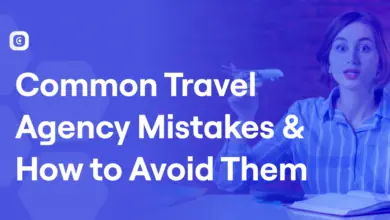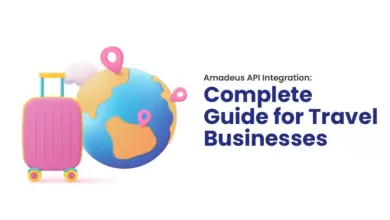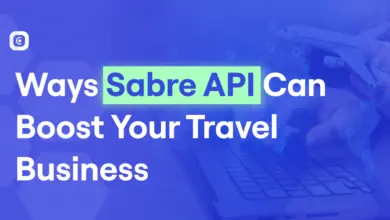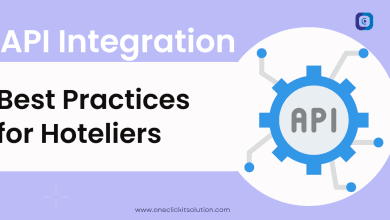Amadeus vs Sabre vs Travelport: A Side-by-Side GDS API Comparison for Travel Businesses
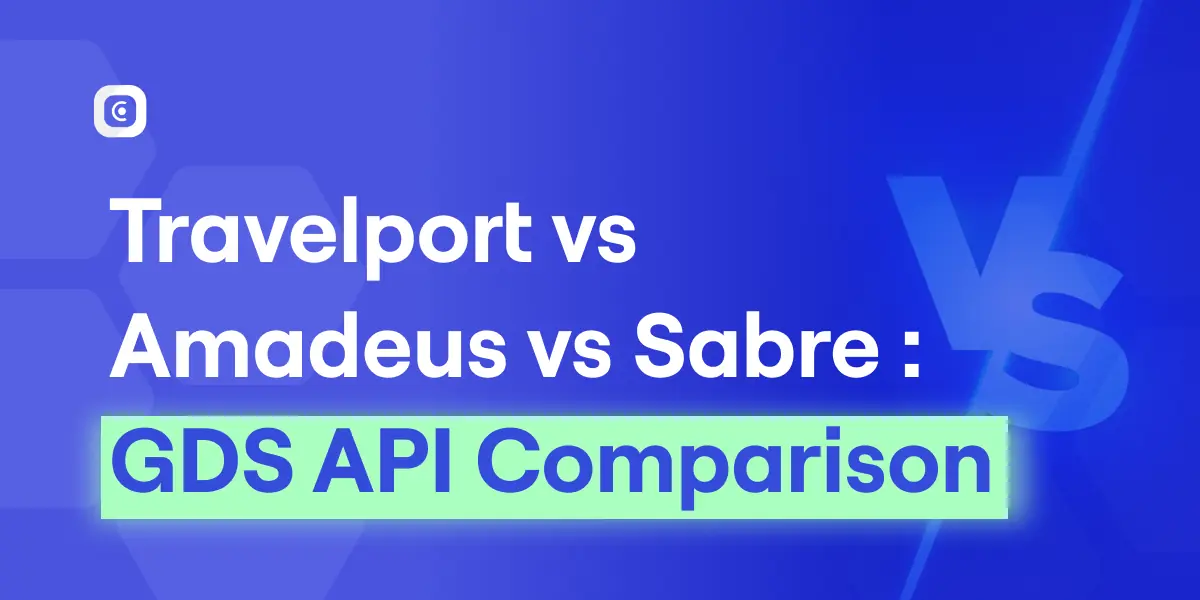
The Global Distribution System (GDS) helps travel agencies by centralizing access to airlines, hotels, and other services. Compare Travelport vs Amadeus or Travelport vs Sabre. Make your comparison and choose the one that suits your needs better. Understand Amadeus vs Sabre vs Travelport for smarter travel tech decisions.
However, the question still remains, which GDS is the best for travel agents? To answer this question in detail, we’ll compare the top three GDSs, Travelport, Amadeus, and Sabre in this blog. Continue reading as we break down their APIs, tools, pricing, and emerging innovations to determine the most popular GDS system.
What is a GDS?
Let’s kick off our discussion by understanding the complete meaning of GDS and how it helps travel businesses. A Global Distribution System (GDS) is a centralized network of various travel inventories that provide real-time access to flights, hotels, car rental, cruises, etc.
This allows the OTAs, tour operators, travel agencies, B2B and B2C businesses to operate a travel portal catering to various booking needs. A travel portal, in simple terms, is a search engine that connects travelers with their preferred services enabling them to book in real-time with accurate pricing.
There are multiple benefits of integrating GDS for both business and travelers
- Real-time pricing and availability
- Acts as a bridge between travel providers and agencies
- Facilitates automated transactions and bookings
- 24/7 customer support for travelers
- Supports NDC (New Distribution Capability) for enhanced travel retailing
Key Factors to Evaluate When Choosing a GDS
Now moving ahead let’s take a quick glance through the factors you must keep in mind when selecting a GDS for your custom travel portal.
- Content Coverage: To ensure that your travel portal provides maximum coverage, check the number of airlines, hotels, cruise lines, and other services included in the GDS.
- API Flexibility: Remember to verify the integration complexity and developer support of the chosen GDS with your provider as it can turn into a hassle in some cases.
- Pricing Structure: Based on your budget and business requirements take setup fees, transaction costs, and contract terms into consideration very carefully as these can sometimes overshoot.
- Post-Sales Support: Once your solution is deployed, you will require training the teams, proper documentation, and customer service in case of emergencies. So discuss these terms with your GDS supplier beforehand.
- Compatibility: To ensure that the GDS performs ideally with your existing systems, check the PMS integration and data synchronization properties of the API.

Travel Content & Coverage: Who Leads the Race?
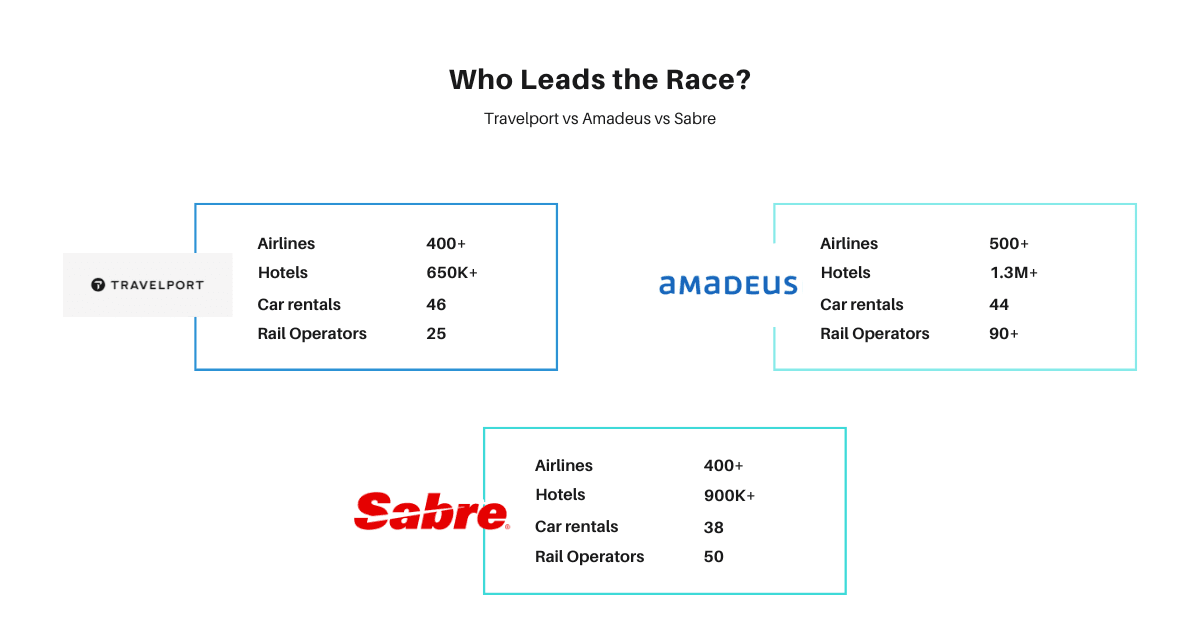
With that being said, let’s slowly start addressing the main question, which is the best GDS available in the market among Travelport, Amadeus, and Sabre? To answer this question, refer to the detailed table below that compares the content and coverage capabilities of the most popular GDSs.
| Feature | Amadeus | Sabre | Travelport |
| Airlines | 500+ | 400+ | 400+ |
| Hotels | 1.3M+ | 900K+ | 650K+ |
| Car Rentals | 44 providers | 38 providers | 46 providers |
| Rail Operators | 90+ | 50 | 25 |
| Cruises | Limited | Strong | Moderate |
| Insurance Providers | 21 | NA | NA |
| Tours and Activities | 300,000+ | Packages from from Canada, Germany, Austria, and Switzerland | Packages from leading cruise lines and tour operators |
| Ocean and River Lines | 30 | 20 | NA |
NDC Support: Future-Proofing Your Distribution
While building a travel portal, it’s important to choose a GDS integration system that keeps your operation afloat even in the future. This is the reason why you must consider NDC parameters. New Distribution Capability, or NDC is spread across the air market to improve the shopping experience for the users.
B2B and B2C businesses cannot opt out of the NDC protocol, which is being gradually introduced by major carriers such as Lufthansa, American Airlines, and United Airlines. These regulations are forwarded from indirect channels powered by legacy EDIFACT protocol. Let’s take a look at how which among Amadeus vs Sabre vs Travelport has the best NDC offerings.
Travelport
Being the first GDS to provide NDC channels, Travelport allows the business to access content from big players like Air France-KLM, American Airlines, Qantas, Singapore Airlines, and United Airlines.
Despite being NDC-complaint, Travelport relies on a hybrid aggregator model with JSON Air APIs for GDS and NDC content. What’s more, the Airline Retailing Maturity (ARM) index of Travelport boasts 4 orders and 9 shop capabilities.
Amadeus
Amadeus features one of the strongest NDC adoption offering scalable solutions for airlines and travel agencies. This GDS has partnered with almost 19 airlines named Iberia, Qantas, Singapore Airlines, United Airlines, and many more integrations in progress.
This GDS relies on XML-based SOAP APIs for providing NDC content with extensive ARM capabilities. Amadeus can equip your travel portal with a variety of shopping options with 5 order capabilities, 5 pay capabilities, and 13 shop capabilities with exclusive discounts.
Sabre
Lastly, Sabre has been upfront for NDC adoption but at a very slow pace. This GDS allows your portal to fetch information from providers like Aviance Group, Qantas, Qatar Airways, Singapore Airlines, United Airlines, and American Airlines.
Sabre allows you to cater to the customer needs from cancellations to refunds with 6 order and 6 pay capabilities. Moreover, you can promote personalized offers in local languages and currencies with 10 shop capabilities.

API Capabilities: Developer Experience Compared
To further determine how fluent every GDS can be in integrating with a travel platform, we’ve compared Amadeus, Travelport, and Sabre from the point of view of a developer.
| Feature | Amadeus | Sabre | Travelport |
| API Type | REST/SOAP | REST/SOAP | REST/SOAP |
| Self-Service Portal | Yes | Limited | Yes |
| Sandbox Environment | Yes | Yes | Yes |
| Documentation | 9/10 (Interactive tutorials) | 7/10 (Complex but thorough) | 6/10 (Fragmented resources) |
| Freemium Model | Yes | No | No |
| Notable Features | AI-powered search | Red App Studio | Universal API |
Tools & Platforms: Beyond Core GDS Functionality
Each GDS offers additional tools to enhance travel booking and management. Let’s discuss them in detail to identify the best GDS when it comes to providing access to tools and platforms.
Amadeus
A major upside of integrating Amadeus GDS into the travel portal is allowing the agents to work from anywhere in the world. This mainly helps small or medium-sized organizations to operate and communicate without having to worry about location.
To help with the corporate booking solution, Amadeus provides a built-in travel and expense management tool named Cytric. This tool allows you to keep track of traveling employees, and their expenses with a dedicated dashboard for quick access and much more.
That’s not it, this GDS is also equipped with a custom payment solution for B2B organizations named Outpayce. Using this travel sellers can create and manage B2B wallets or even make payments with virtual cards whenever required.
Sabre
The most enticing benefit of Sabre is that it connects sellers and suppliers in a marketplace. With Sabre Red 360, businesses can communicate directly with their suppliers and sort their needs out. It also showcases carbon offset data for climate-conscious users.
Ideal for TMCs and corporate clients, Sabre provides an exclusive tool called GetThere. Here, global and mid-sized companies across 11 countries are listed, ready for new opportunities. What’s more, it can be accessed from any device without any hassle.
To secure all the payments made in Sabre GDS, this API utilizes Conferma Pay for all virtual card payments. Businesses can choose from over 50 banks in around 100 currencies to expand their operations.
Travelport
Last but not least, Travelport provides access to a variety of tools with its retailing platform, Travelport+. This software tends to save almost 1.5 hours/day for agents, if compared to traditional GDSs out there.
To meet the growing business needs, Travelport introduced its first flagship agent desktop interface in 2023, Smartpoint Cloud. This allows travel agents to create personalized itineraries with minimum hassle. The Travelport API integration has helped many businesses streamline their operations.
Another tool of Travelport named Deem favors corporate booking portals with its dedicated features. However, this GDS does not provide dedicated support for payments. They did not pay much attention to streamlining transitions themselves, they chose a suitable provider.
Pricing & Time-to-Market: Hidden Costs Revealed
The fees required to integrate a GDS provider vary according to the business requirements. Below is a detailed tabular comparison highlighting transactions, subscription models, and custom integrations.
| Cost Factor | Amadeus | Sabre | Travelport |
| Setup Fees | High | Medium | Medium |
| Transaction Fees | Per booking | Per booking | Per booking |
| Volume Discounts | Available | Available | Available |
| Integration Time | 4-6 weeks | 6-8 weeks | 4-6 weeks |
| Time to Market | 3–6 months | 4–8 months | 2–5 months |
How to Connect to a GDS: A Step-by-Step Guide
Once you’ve finalized a GDS suitable to your business, refer to the process below for integrating a GDS system into your travel portal.
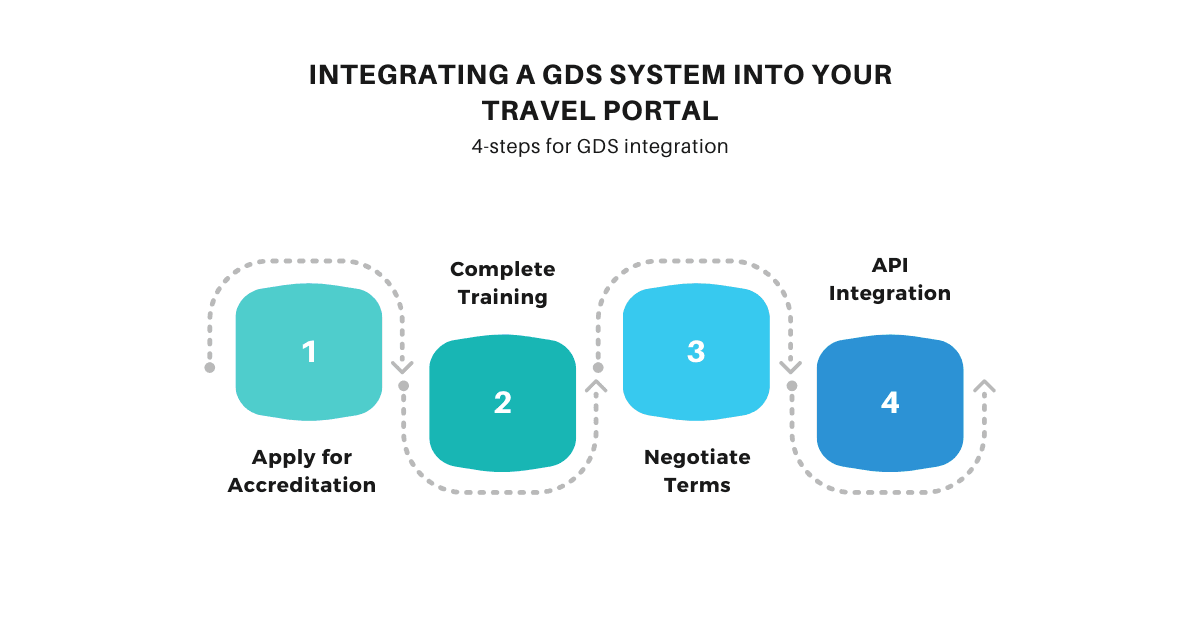
Step 1: Apply for Accreditation
Starting off, you need to get accredited with IATA or a local travel authority to review your eligibility requirements, verification, and identification purposes.
Step 2: Complete Training
Once done, you must enroll in mandatory GDS certification provided by IATA to properly understand the fundamentals of fares, ticketing, and other travel industry aspects.
Step 3: Negotiate Terms
After completing your training, you can compare options with a reliable provider such as OneClick and discuss factors like business requirements, SLAs, transaction fees, and volume discounts.
Step 4: API Integration
Finally, when all the terms and conditions are discussed, proceed with GDS API integration in your portal. You can choose between on-premise and cloud-based deployment.
Which GDS is Right for You? A Decision Checklist
In case you’re lost between options and wondering which GDS among Travelport vs Amadeus vs Sabre is perfect for your business, here’s a quick checklist that can help.
- Understand the size and transactional volume of your business to finalize a GDS that fits your requirements the best.
- To ace your targets without missing, you must have an idea of the targeted regions and ideal suppliers. This strategy will help you choose a GDS with maximum output.
- You must have a brief idea of what your travel portal will offer currently and in the future. Choose GDS according to the preferred content coverage from air and hotel to car, rail, and cruise services.
- Regardless of the GDS you prefer, consider factors like API flexibility and developer support as it’ll be a necessity as you decide to scale your operations.
- Another set of factors that should be considered are pricing, contract terms, and customer support. Connect with a variety of partners and make a decision.
The Final Verdict
Choosing between Sabre vs Amadeus or Travelport vs Sabre depends on your business needs. Evaluate Amadeus vs Sabre vs Travelport based on APIs, pricing, technical requirements and NDC support. Understanding travelport amadeus comparisons and Travelport vs Amadeus features ensures the best GDS fit for your travel business.
FAQs
Travelport and Amadeus are said to be the most suitable choice for small travel agencies as they provide an extensive global presence with the required flexibility.
Definitely. Businesses can seamlessly integrate multiple GDS APIs as per their preference to access real-time data from various suppliers. OneClick not only provides access to multiple GDS APIs but also provides 24/7 support.
Traditional GDS APIs provide preset modules due to which they boast standard pricing. However, NDC is more dynamic and personalized resulting in a varying pricing structure.
Common challenges in GDS API integration include data consistency and accuracy, security concerns, authentication and authorization issues, managing API versioning, and dealing with inconsistent or incomplete documentation.
Yes, GDS allows businesses to streamline their operations by catering to international customers with convenient features like multilingual and multi-currency payment options.


